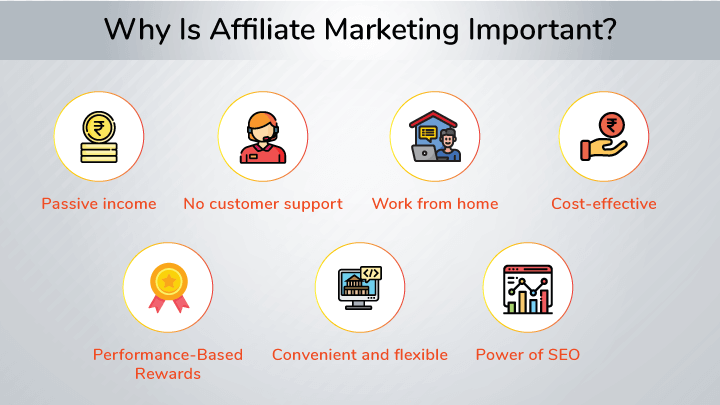Content Attributes
Affiliate marketing is the method to increase the sales of our products and/or services from an external website to our online store, in exchange for a certain commission.
It is an online marketing strategy based on the agreement between an advertiser, be it a company or an e- commerce, and another company (conventional intermediary) to whom they pay an agreed commission to help them sell and promote their business.
We could also see it as the word of mouth of a lifetime, but passed to the digital format in which someone else is in charge of recommending us, promoting us and enhancing our brand image. The difference: the sale resulting from that recommendation has a cost (commission).
How does this collaboration work?
It usually consists of collaborating with an influential person who owns a blog or website with high traffic and user interaction. The Companies work with professional affiliate networks that are responsible for selecting the best spaces to promote the brands.
The company that hires the affiliate service must deliver corporate, creative or advertising material. So that affiliate marketers can incorporate it into their website, giving your brand greater visibility without losing its visual identity.
Through the incorporation of a link (banners, advertisements, links) it is sought that the final client clicks on it. And through a reference code to read the source of that click. The affiliate will charge a commission percentage of that concrete sale.

As a company, we should not only focus the benefit of this marketing technique on the final sale. Although that is the potential objective. We have to think that Affiliate Marketing consists mainly of enhancing our brand visibility and being able to promote and recommend our products and/or services. Taking advantage of the prestige of that specific platform on which we decide to promote our brand. Which in turn helps us to increase our sales.
Although affiliation usually done through web pages. It can also done through email marketing campaigns or even social networks.
Why does it work?
Nowadays, people tend to look at the opinions and recommendations of certain products and services. That have already tried and bought by other people. There is a strong concern of making mistakes in our purchase process, “wasting” our money with a failed investment. That is why, if we choose to take advantage of the prestige of our affiliate, we will have a successful sale guaranteed.
To do this, the profile of our affiliate must know how to perform its role properly, must control various facets and must guarantee its activity and direct traffic.
Affiliate Marketing players
To better understand how this model works, let’s take a look at the three big players in affiliate marketing:
The advertiser:
We call “advertiser” to the company that sells the products or services promoted through affiliates. From online subscriptions to home appliances, the world of affiliate marketing has a place for all types of advertisers. In addition, this strategy can be adapted to very different company sizes and budgets, from large multinationals to sole proprietorships. The advertiser is in charge of designing the creative material (from a banner to a simple link or telephone number) that the affiliate will be in charge of promoting.
The Affiliate:
Affiliates are the intermediaries that connect advertisers and consumers in exchange for a commission. As with advertisers, the world of affiliates has room for all shapes and sizes, from the individual blogger looking to monetize their website to large affiliate companies. Where the advertiser provides the creative material, the affiliate is generally free to create the promotional content, for example by writing a blog post about the product.
The consumer:
At the end of this entire process, we have the consumer or end user, who gives meaning to this strategy. They are the ones who see the ad posted by the affiliate, click on a link (or submit their information via a form), and end up visiting the advertiser’s website to complete the conversion.
Cookies, the Allies of Affiliate Marketing
This affiliate marketing guide would not be complete without a mention of cookies. As they are essential for proper attribution of results.
As you may already know, cookies are small files that web servers send to Internet users hard drives and contain information about their preferences and browsing patterns.
Although invisible to us, cookies are essential in everyday internet use. If you have ever asked a website to remember your username and password, or have seen ads related to something you just searched for, you have already used cookies.
In affiliate marketing, cookies are used to “remember” a user’s behavior. For example which links they click. In this way it is possible to track their actions to know how they have come to buy the advertiser.
Thus, when the user clicks on an affiliate link, the link through which they reach the destination website (the advertiser’s page) contains information about the affiliate, the ad they clicked on and the amount of the commission.
Let’s See The Whole Process in More Detail:
- The affiliate establishes an agreement with the advertiser. Through which they will promote their products or services in exchange for a commission.
- From that moment on, every time the affiliate mentions the advertiser’s products or services on his website. He will include an affiliate link.
- The consumer visits the affiliate’s website and clicks on one of the links. At that time, a cookie stored on your computer.
- The consumer makes a purchase (or other conversion) on the advertiser’s website. While completing the process, the advertiser checks your computer for affiliate cookies.
- Upon finding the affiliate cookie, the advertiser notes the corresponding commission. This commission added to a report where the advertiser collects all the traffic and conversions that come through the affiliate link.
- At the end of each billing period (usually monthly), the advertiser pays the corresponding commissions to the affiliate.
Why are we Interested?
- It helps us reach new audiences (even if you don’t sell) that we didn’t have reach.
- It helps us increase our list of subscribers by gaining more leads and therefore visibility and (quality) web traffic.
- This helps to increase our sales, and although giving a percentage of commission. We must bear in mind that otherwise we would not have obtained it.
- It helps us promote, recommend and make our brand visible.
- Everyone wins: company and affiliate.
What are the Benefits of Affiliate Marketing or Affiliates?

- It is profitable: The advertiser, normally an e-commerce, only pays if the client performs a specific action that interests them. They usually ask for CPC (they pay according to the clicks on certain links), CPL (conversion of the client into a user, whether it is subscribing, filling out a form; that is, obtaining client data) CPA (paying for the conversion of each client) or CPM (pay per thousand impressions).
- Simple analytics: Affiliate programs can easily followed through statistics and data with which to perform metrics, comparisons and studies.
- Constant stream of income: Even without being behind the computer. Being a job that depends on traffic, redirects and purchases through the Internet, you can make money at any time.
- Safe work: It has practically no risk, you do not have to invest in products or services to market. But you “promote” the articles of other companies. In the same way, affiliate-marketing does not pay if the process does not work.
The 5 Principles of Affiliate Marketing
To end this guide to affiliate marketing, we are going to review a very important issue: the principles. In everything we do in digital marketing. It is essential to maintain a series of good practices that help us obtain long-term profitability. So, let’s see what are the 5 key principles to be successful in affiliate marketing.

1) Be transparent
To create a good relationship between advertiser, affiliates and consumers. It is necessary that all parties have very clear terms of that relationship. And ultimately, it is the responsibility of the advertiser to ensure that these conditions of transparency are met.
Advertisers and affiliates must reach an agreement that satisfies both parties and makes clear what behaviors desired and unacceptable. In particular, it is necessary to clarify that affiliate links must labelled as such. And that potential conflicts of interest must disclose to consumers.
2) Look for relevance
There is no use working with lots of affiliates. If what they have to offer is not relevant to the advertiser’s desired customers. In other words, if you have a vacuum cleaner brand, you don’t want to advertise on gardening blogs. Placing trust in your affiliates does not free you from “doing your homework“. You have to research your audience and your potential affiliates to find a good match between the two.
3) Go to credible sites
It’s not exactly a secret that the internet is full of spam, but you want (and should) do things right. If your ads are shown on unreliable sites, that lack of credibility will end up infecting your brand. So before you establish a relationship with an individual affiliate or network. Research them thoroughly and make sure you control what kind of sites your advertising will be displayed on.
4) Avoid intrusive advertising
Banners that steal half the screen, loud pop-ups… Users are increasingly fed up with intrusive advertising, and the rise of ad blockers proves it.
Affiliate marketing does not have to be synonymous with low-quality advertising. If the links to your products and services are wrapped in content that adds real value to the user. You will have much to gain from establishing a good relationship with them.
5) Work long term
If you focus on immediate results, you will be much more likely to fall into tactics that do not add anything to your brand. Focus on finding quality affiliates and take care of your relationship with them step by step. You will see how the investment of doing things well always ends up being worth it.



